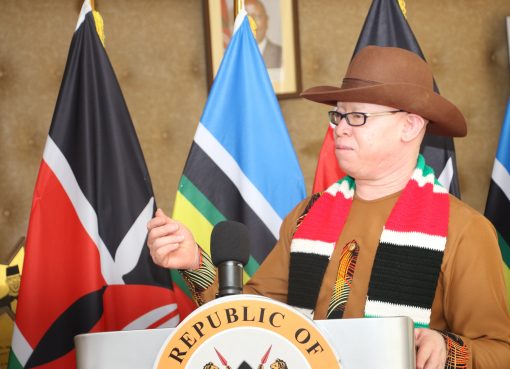Kenya’s Innovation Ecosystem is ranked eighth among the 28 economies in Sub-Saharan Africa in the 16th Edition of the Global Innovation Index 2023 report by the World Intellectual Property Organisation.
When Kenya performs well regionally, it lags behind globally, specifically in the dimensions of skills, infrastructure, and financing. The country was ranked 100 out of 132 global economies as per the GII 2023 report. The report ranks countries according to their innovation capabilities.
This was said by Cabinet Secretary (CS) for Youth Affairs, Creative Economy, and Sports Ababu Namwamba while launching the Kenya Innovation Agency’s (KeNIA) second strategic plan for 2023–2027 at a Nairobi hotel on Thursday.
The plan aimed at meeting the Agency’s mission statement of developing and managing a dynamic national innovation system that catalyses job creation and wealth creation.
The CS said the National Government has recognised the crucial role that innovation played in accelerating the country’s bottom-up economic transformation agenda, which targets innovation as a key anchor.
The CS therefore called upon KeNIA to develop an information portal on funding opportunities, saying some potential sources of funding, such as the Youth Enterprise Development Fund, have not been exploited adequately by Kenyan innovators.
“KeNIA should develop an information portal that can support innovators in creating awareness about these opportunities,” Namwamba said.
Further, he outlined the role that innovation plays in the Kenya 10-year Innovation Master Plan, which was unveiled by President Ruto during the Kenya Innovation Week—Commonwealth Edition in 2023.
The CS noted that KeNIA has made an effort to develop an institutional pillar document which includes the startup ecosystem, institutional capacity, commercialization systems, promotion and awareness, policy, legal, and regulatory frameworks.
While maintaining that it is essential to understand the country’s historical context, Namwamba disclosed that the Kenyan Innovation Ecosystem has been powered by industrialization, such as the pre-independence industrialization initiatives of 1994–1995, the import substitution strategy (1945–1980), structural adjustment programmes (1980–1999), Vision 2030, science and technology, the Innovation Act (2013), and the current digital transformation agenda.
The CS highlighted the legislation supporting innovation, including the Science and Technology Act (STI) Act 2013, IP Acts 2001, and STI Policy 2020, terming it as a good foundation for interventions with the aim of improving the ecosystem.
Addressing the challenges facing the innovation ecosystem, Namwamba noted that Kenya does not have a common and coherent strategy and national vision for the innovation ecosystem, despite having multiple documents in place.
He assured that the 10-year Innovation Master Plan would help to expand a coherent innovation policy strategy to drive the ecosystem forward and urge KeNIA to provide leadership in this aspect.
Namwamba, however, noted that existing innovation hubs were predominantly in urban areas, leaving rural areas underserved.
“I issued policy guidelines for KeNIA to transform the existing Youth Empowerment Centres into innovation hubs. I anticipate the completion of this process at the earliest,” directed the CS.
He also cited women’s participation in the Kenyan innovation ecosystem as comparatively low, which is reflected in the limited number of women-led start-ups and women-managed hubs.
To address these challenges, the CS urged KeNIA to create an inventory, document innovations and start-ups at the county and national levels, and increase awareness of the services offered by innovation hubs to the public.
Namwamba added that KeNIA should formulate recommendations to foster an innovation culture in Kenya and how the government provides tax reliefs to investors in innovation.
“KeNIA needs to enhance appropriate skills for innovation development, commercialising innovations, and managing innovation hubs since it will contribute to boosting Kenya’s innovation performance in future rankings,” the CS remarked.
He added that KeNIA needed to map out the funding landscape for innovation in Kenya because not all sectors attract funding, citing health, housing, and water as some of the sectors which attracted less funding, while agriculture, Fintech, energy, and e-commerce were the top four best-funded sectors.
Further, the CS encouraged KeNIA to engage the Youth Enterprise Development Fund on the possibilities of restructuring the youth fund, which requires title deeds, logbooks, and healthy bank statements which innovators may not have.
He advised the Agency to strengthen the capacity of innovators through training, providing learning and growth linkages, supporting the commercialization of innovations, and facilitating access to funds for youth and other vulnerable groups.
“The funding ceiling ranging from Sh100,000 to 1 million is low for innovators,” added Namwamba, promising to progress the discussion at the earliest opportunity.
Namwamba called on KeNIA to support innovators in protecting their innovations through Intellectual Property Rights.
He called upon stakeholders to collaborate with KeNIA for the success of initiatives put in place that aim to enhance Kenya’s shared socio-economic development.
Speaking on behalf of the Board of Directors, KeNIA Chairman Prof. Peter Ogada highlighted the rational process developed for the strategic plan, the strategic direction that KeNIA wants to pursue in the next 5 years, and the key pillars of the strategies.
“It is a very important year for KeNIA since the Agency wants to ensure that building on the successes that have been revised over the last two years will have a positive impact on the Kenyan Innovation Ecosystem,” stated Ogada.
He added that in this second strategic plan, KeNIA is building strongly on the successes that were delivered by the first strategic plan, 2018–2022, which came to an end in 2022, thereby providing one of the key justifications as a new strategic plan is formulated.
Ogada lauded the current government for putting an effort into innovation and using the same to create jobs for the youth in this country.
He said that at the regional level, KeNIA has also aligned the strategic plan with science technology and transfer innovation technology.
By Sharon Atieno and Peace Maziga




